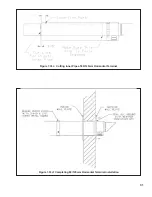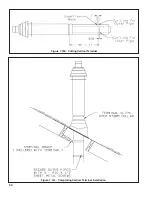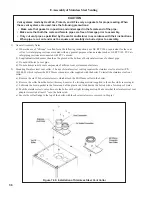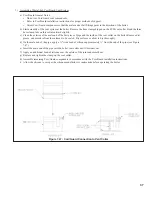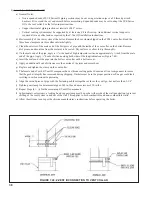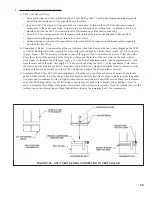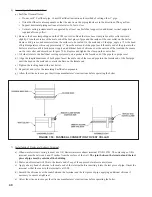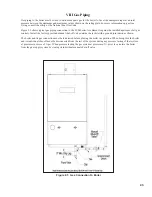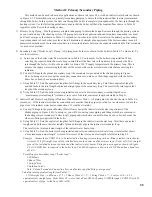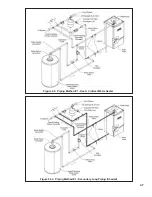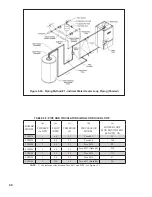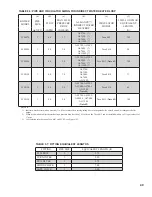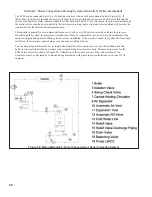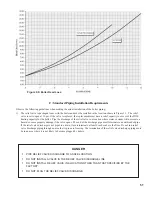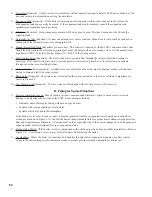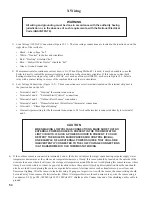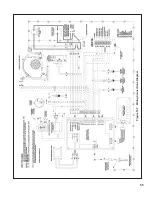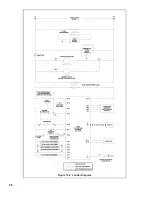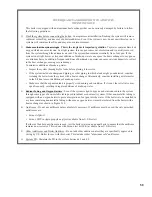
Method 1: Primary/Secondary Piping
This method can be used in heat-only applications as shown in Figure 9.2 or with an indirect water heater as shown
in Figure 9.3. This method relies on primary/secondary pumping to ensure that the required flow is always maintained
through the boiler. In this system, the flow rate through the boiler is completely independent of the flow rate through the
heating system. Use the following guidelines to ensure that the boiler will have the required flow shown in Table 9.1
regardless of the flow in the heating system.
1) Primary Loop Piping - Size the primary circulator and piping to obtain the design flow rate through the heating system
as you would on any other heating system. All piping between the expansion tank and secondary connection tees must
be at least as large as that shown in Table 9.5, column (a). In order to keep the flow rates in the primary and secondary
loops independent of each other, provide at least 8 diameters of straight pipe upstream of the first secondary tee and 4
diameters downstream of the second secondary tee. Keep the distance between the expansion tank and the first secondary
tee as short as practical.
2) Secondary Loop (“Boiler Loop”) Piping – All piping must be the size shown for the boiler in Table 9.5, column (a). To
size the circulator:
a) Select one of the boiler water flow rates shown in Table 9.5, column (b) for the boiler being installed. When
selecting the required boiler flow rate, keep in mind that if the flow rate in the primary loop exceeds the flow
rate through the boiler, it will not be possible to obtain a 180°F supply temperature in the primary loop. This is
because the supply water exiting the boiler will be mixed with cooler system return water before entering the
radiation.
b) Count all fittings in the planned secondary loop (the secondary loop consists of the shaded piping in Figure
9.4a). In doing so, do not count the secondary connection tees, unions, or the fittings supplied with the boiler
(these have already been accounted for).
c) Using Table 9.7, find the equivalent lengths of all fittings in the secondary loop. Total these equivalent lengths
and add them to the total length of planned straight pipe in the secondary loop. The result is the total equivalent
length of the secondary loop.
d) Using Table 9.5, find the boiler size being installed and select a boiler secondary circulator that shows a
“maximum equivalent length” (column e) in excess of the total equivalent length calculated in Step 2c.
3) Indirect Water Heater Loop Piping (If Indirect Water Heater is Used) – All piping must be the size shown in Table 9.6,
column (a). If the indirect water heater connections are smaller than the pipe size called for in column (a), reduce the
pipe size at the indirect water heater connections. To size the circulator:
a) Count all fittings in the planned Indirect Water Heater Loop (the indirect water heater loop consists of the
shaded piping in Figure 9.4b). In doing so, you will be counting some piping and fittings which are common to
the heating system secondary (“boiler loop”) piping and which were counted in Step 2a above. Do not count the
elbows or fittings supplied with the boiler.
b) Using Table 9.7, find the equivalent lengths of all fittings in the indirect water heater loop. Total these equivalent
lengths and add them to the total length of planned straight pipe in the indirect water heater loop.
The result is the total equivalent length of the indirect water heater loop.
c) Using Table 9.6, find the boiler size being installed and select an indirect water heater loop circulator that shows
a “maximum equivalent length” (column f) in excess of the total equivalent length calculated in Step 3b.
Example – Assume that a FCM120 is to be installed in a heating system along with an Alliance indirect water heater.
A total of 15 ft of straight pipe will be installed between the boiler and the primary loop. A total of 20 ft of straight
pipe will be installed between the boiler and the indirect water heater. Fittings are arranged as shown in Figure
9.3. A 9.0 GPM flow is required in the boiler loop. The MS-40 requires a flow rate of 8 GPM and has a head loss
of 3.0 ft.
Total fittings in Secondary loop (“boiler loop”):
6 90 Elbows
2 Runs of Tees
1 Swing Check
2 Isolation Valves
Note: Unions, Secondary Connection Tees, and factory supplied fittings are ignored.
Calculate total equivalent length from Table 9.7:
15ft Straight Pipe + 6 Elbows x 2.75 + 2 Runs of Tees x 1.75 + 1 Swing Check x 7 + 2 valves x 0.6 = 43.2
equivalent feet straight pipe. From Table 9.5, we see that a Taco 0014 will pump 9 GPM through a FCM120 with 61
equivalent feet of pipe, so the Taco 0014 is OK.
Summary of Contents for FREEDOM
Page 8: ...8 Figure 1 Wall Mounting Hole locations ...
Page 9: ...9 Figure 5 2 Boiler Mounting Hardware ...
Page 11: ...11 Figure 6 1 Boiler Installed In A Confined Space Ventilation Air From Inside ...
Page 42: ...42 FIGURE 7 51 CONDENSATE PIPING ARRANGEMENT ...
Page 55: ...55 Figure 10 1 Wiring Connections Diagram ...
Page 56: ...56 Figure 10 2 Ladder Diagram ...
Page 57: ...57 Figure 10 3 Wiring of Isolation Relay for Control of Two Heating Circulators ...
Page 60: ...60 FCM Series Lighting and Operating Instructions ...
Page 66: ...66 FIGURE 12 2 BASIC MENU TREE ...
Page 75: ...75 ...
Page 77: ...77 ...
Page 79: ...79 ...
Page 80: ...80 ...
Page 81: ...81 ...
Page 83: ...83 150 151 152 153 154 155 ...
Page 84: ...84 156 157 158 159 160 161 ...
Page 85: ...85 162 ...

